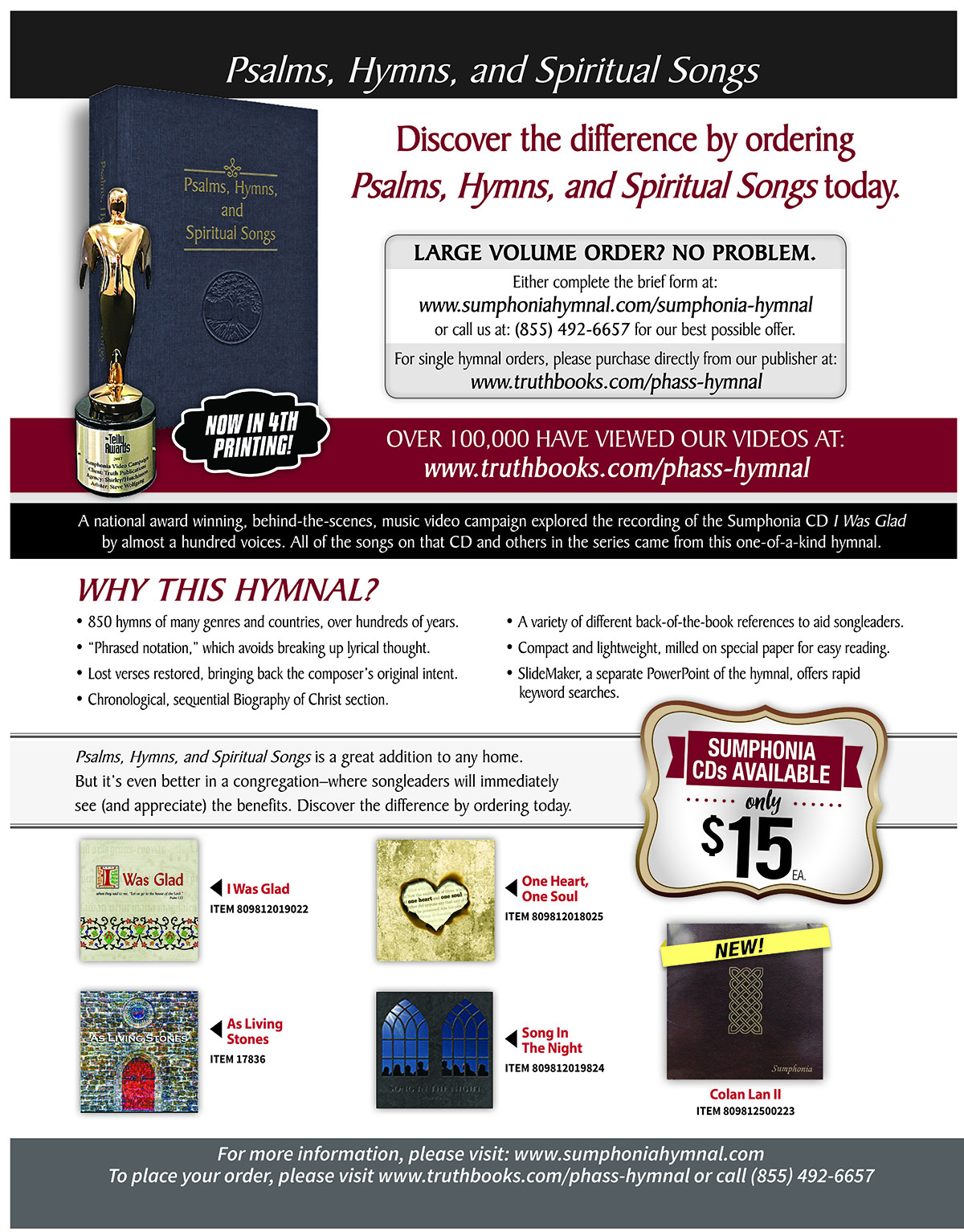

by Steve Wolfgang
Synopsis: Worship includes observing the Lord’s supper and laying by in store on the first day of the week, along with scriptural preaching, prayer, and praise. In this regard, Steve shares the benefits of Psalms, Hymns and Spiritual Songs.
As a non-profit religious publishing organization, our mission is to produce and distribute a wide variety of material intended to help Christians (1) grow in the grace and knowledge of the Lord, (2) edify one another as we worship together in local congregations, and (3) share the good news of God’s grace, i.e., the forgiveness of sins through Jesus Christ, and the hope of eternal life. The materials we produce and publish include an innovative full commentary on the entire Bible, several complete sets of Bible class curricula, a wide variety of tracts and other Bible study materials. Several years ago, we also underwrote the production of the new hymnal, Psalms, Hymns, and Spiritual Songs.
The worship of Almighty God is the most important thing that Christians do. While it is true that a single Christian can certainly worship God individually, and worship should not be confined only to what happens within the four walls of a building (Rom. 12:2), there is a special sense in which Christians are acting together congregationally, and worshipping collectively. It is also true that, in some ways, what a Christian does in any aspect of life should glorify God and constitute worship. What we do together as Christians in acts of worship specified in the New Testament is quite distinct from “glorifying God” by mowing the yard of an elderly Christian or washing a neighbor’s car as an act of service.
Christians gather on the Lord’s day, just as early disciples did from the beginning of the New Testament church. They do so in order to (1) commune in the Lord’s supper, (2) offer prayers to our heavenly Father, (3) diligently study the written revelation of God, and (4) give of their earthly finances so that (a) the gospel may be spread, (b) other Christians may be edified, and (c) scriptural benevolent works may be accomplished. These all constitute acts of worship as exemplified and commanded in the New Testament.
Additionally, we may worship, either individually or in concert with other Christians, in singing hymns of praise to God. To that end, we published a collection of Psalms, Hymns, and Spiritual Songs (often abbreviated PHaSS) in 2012. As one of the editors, I have been asked to highlight its features as one means of what we are trying to do in “Taking His hand, helping each other home.”
The content of this hymnal began with a selection of 550 hymns, identified through an internet survey in which participants ranked those hymns most appropriate for a congregational hymnal. These 550 hymns were identified as familiar and widely used by many Christians, and thus represent a core “repertoire” in many churches. They were selected, identified, and highly ranked by Christians across the country from the more than 1800 hymns which appeared in at least one of the eight hymnals most widely used by Churches of Christ in the 20th century. Thus, more than 1200 hymns, including some “personal favorites” as well as hymns well-known in some localities, were not included since they were not highly ranked by those investing the time to participate in the internet survey.
To this core of 550 familiar hymns, 300 titles were added from various genre (including gospel, contemporary, folk, New English Renaissance, and high church hymns) appropriate for congregational worship. These 300 titles also included hymns written by brethren in recent decades, which were “blind-reviewed” based on content, poetic and musical quality and potential for use in congregations wishing to learn new hymns. Thus the content of PHaSSincludes 850 hymns that are both old and new, representing a variety of musical and poetic styles. As a collection, they reflect an emphasis on quality and suitability for congregational worship rather than being skewed toward any particular favorite genre or personal preference.
Of the many distinctive features in PHaSS, perhaps the most noticeable is the concept of “Phrased Notation.” This unique feature sets the width of a hymn by the length of phrases that fit on a line, rather than by the musical notation. Phrased Notation then “wraps” the music around those phrases. The result is a series of unbroken clauses and couplets, as in a book of poetry. These unbroken phrases let the worshiper visualize, group, and more easily comprehend the meaning of the phrases as they are being sung. Phrased Notation has proven to be effective in promoting the comprehension of uninterrupted thoughts within a hymn.
The layout of hymns, centered on each page, causes them to appear in various widths in Phrased Notation. Hymns with longer phrases will occupy the full width of the page. Other hymns with varying meters will appear as “narrow” hymns with significant white space surrounding them. In some hymns, the meter demands different staff widths within the same hymn. To help orient how the eye “sees” each hymn, titles of each hymn (also of varying length) appear with spanners which run the full width of each page.
The first section of Psalms, Hymns, and Spiritual Songs contains psalms and psalm derivatives. A second section contains hymns and spiritual songs. This section is ordered in a God-first sequence, beginning with hymns of praise, followed by hymns about the life of Christ, continuing with hymns addressing themes such as salvation, fellowship, submission, commitment, the Christian life, prayer, evangelism, heaven, and eventually concluding with songs of invitation.
Each hymn was systematically and thoroughly reviewed in terms of word choice and verse selection. With few exceptions, hymns familiar to the primary audience of this hymnal were published in the most common version, as determined by its appearance in the hymnals most frequently used among Churches of Christ in recent generations. This editorial policy gave greatest emphasis to language that was biblical, poetic, and original or standard, while giving lesser emphasis to language that privileges momentary trends or accommodates transient fashions.
In unfamiliar hymns or those using archaic language, the lyrics were modernized when possible. Yet, in more familiar hymns, the wording remains unchanged. Unfamiliar hymns with problematic verses were occasionally “hybridized” using superior couplets or quatrains from existing phrases within the hymn. On rare occasions, one or two words in familiar hymns were altered to achieve consistent meter or to prevent worshipers from stumbling over inconsistent phrasing, by eliminating the need to frequently double-check the hymn page for unpredictable terms or rhythms.
A number of outstanding hymns, widely known and frequently sung by prior generations of Christians, have dropped out of the repertoire of modern hymnals but are reintroduced in PHaSS. In some hymns, excellent original verses have likewise disappeared from hymnals over time, but are incorporated in this hymnal. The criteria necessary for reintroduction were biblical expression, worthy content, and poetic quality. Also, several hymns in PHaSS contain optional verses. These verses, appearing below the staff, are borrowed from other hymns with a similar message and meter. They demonstrate how optional verses can extend a hymn while giving the borrowed verse a fresh use.
All hymns and tunes in Psalms, Hymns, and Spiritual Songs were copyedited to fit a style sheet. The hymn style sheet was developed according to Standard English. One of the most distinctive features of this hymnal is that the word “Lord” appears in small caps as “LORD” when it refers to YHWH, as in some Bibles. The variable capitalization of “Lord” and “LORD” allows this hymnal to serve as a teaching tool, helping worshipers to sing with a clearer understanding.
Additionally, there are various “composite” hymns included as a distinctive feature of Psalms, Hymns, and Spiritual Songs. These hymns contain verses from other well-known hymns sharing the same message and meter. These composite hymns address topics of salvation, pilgrimage, spiritual warfare, heaven, as well as the crucifixion and kingship of Christ. Most of these composite hymns introduce new or underutilized music appropriate to these very familiar verses. For Christians and congregations interested in learning the new music, these composite hymns can revitalize older verses and provide an uncomplicated and spiritually edifying medley-like worship experience.
In addition to unique features such as Phrased Notation, capitalizations of Lord and LORD, composite hymns, hybridized verses, and optional verses, other distinctive aspects of this hymnal include dagger endnotes and a hymn-based metrical index, and several additional features.
It is our fervent desire that worship leaders will make full use of this hymnal, exercising good judgment throughout. Worship leaders have great discretion in selecting the ideal tempo, volume, and other aspects of worship in song. Worship leaders may use the topical index to develop themed services, the metrical index to match hymns with various tunes, and the endnotes to consider alternative keys and arrangements. We have provided these tools with the trust and confidence that dedicated and thoughtful worship leaders will use them judiciously.
Author Bio: Steve has worked with the church in Downers Grove (suburban Chicago) since 2008. He and his wife, Bette, have two adult children and three grandchildren. His blog, eklektikos, can be read at href="https://stevewolfgang.wordpress.com/">stevewolfgang.wordpress.com. He can be reached at stevewolfgang@aol.com or wolf@uky.edu.
